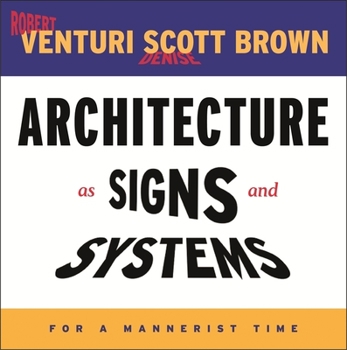Architecture as Signs and Systems: For a Mannerist Time
(Part of the The William E. Massey Sr. Lectures in American Studies Series)
Robert Venturi exploded onto the architectural scene in 1966 with a radical call to arms in Complexity and Contradiction. Further accolades and outrage ensued in 1972 when Venturi and Denise Scott Brown (along with Steven Izenour) analyzed the Las Vegas strip as an archetype in Learning from Las Vegas. Now, for the first time, these two observer-designer-theorists turn their iconoclastic vision onto their own remarkable partnership...
Format:Hardcover
Language:English
ISBN:0674015711
ISBN13:9780674015715
Release Date:December 2004
Publisher:Belknap Press
Length:264 Pages
Weight:0.10 lbs.
Dimensions:0.7" x 8.8" x 8.8"
Customer Reviews
2 ratings
"Nothing is fair or good alone"
Published by Thriftbooks.com User , 17 years ago
It is difficult to imagine an architect more genuinely American than Robert Venturi. His Americaness consists in a horizontal vision of history, in a method that embraces case data as its system, and in an obstinate realism with regards to the punctilious registration of the material furnished by daily life . This is well summarised in one of the two slogans on the back cover: "Evolutionary Pragmatism rather than Revolutionary Ideology." Architecture as Signs and Systems can be considered as a kind of "scientific autobiography" by Venturi and Scott Brown. The couple from Philadelphia develops the theories contained in their preceding books in the light of their own projects, which are presented here as being demonstrative. It is not easy to distinguish the personal contributions coming from an association that has lasted longer than that of Burnham & Root. Thanks to the book's autobiographical confessions, the decisive influence that Denise Scott Brown had on her husband now emerges completely. A South African architect and urban planner, Scott Brown was trained in Europe. The interests they have in common for functionalism, industrial architecture from Modernism's beginnings, and the social and urban context of design are the fruits of her apprenticeship at Architectural Association in London. London was the new pulsating centre for post-war architectural culture. It was also the capital of the Modernist Architectural Movement's internal criticism, spawning the Brutalism of which Alison and Peter Smithson (and Team X in general) were primary exponents. Above all, it was Scott Brown's fascination with South African folk art incorporating Western imagery (frowned upon by purists) that prepared Scott Brown for the impurity of Las Vegas, allowing us to understand the other slogan featured on the back cover: "Serious beauty may lie in what you see and can't, at first, accept." Scott Brown's influence on Venturi was legible as early as 1966, with the publication of Venturi's brilliant manifesto Complexity and Contradiction in Architecture, ending with a picture of a billboard-lined street. It is a known fact that Learning from Las Vegas (1972) is based more on her urban studies than his theoretic and historical research. However, Venturi's realism comes from his interest in all that is ordinary and, above all, vernacular. Without doubt, Pop Art was one of the fundamental basis for his vision of architecture as a means of communication for the multiculturalism of the present and future world. This brings him to see Times Square and certain areas of Tokyo (dominated by enormous electronic screens relentlessly bombarding pedestrians and motorists with information and advertising) as a Saint Mark's Square of our times. It is impossible to not see Ed Ruscha's Twenty-six Gasoline Stations (1962) behind today's annoying electronic panels with their giant connotative Venturian writing. Moreover, being a Realist in the USA cannot be the same as in Europe
Excellent!!!!
Published by Thriftbooks.com User , 19 years ago
This book is a pleasure to read. The words taste almost of chocolate. It is the best book by Venturi, Scott Brown since Learning from Las Vegas. Whether you are an architect, interested in architecture, or just their ideas, you won't be disappointed.





